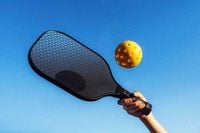Pickleball, once a little-known pastime, has exploded into the fastest-growing sport in the United States, drawing nearly 20 million players of all ages to courts across the country. But as its popularity soars, a new and troubling trend has emerged: a sharp rise in eye injuries linked to the sport, especially among older adults. According to a study published on October 16, 2025, in JAMA Ophthalmology and widely reported by outlets like The New York Times, Managed Healthcare Executive, and Medical Republic, these injuries have reached “alarming” levels over the past four years, prompting calls for new safety guidelines and greater awareness among players.
The numbers tell a striking story. Researchers analyzed emergency room data from a nationally representative sample of U.S. hospitals, focusing on pickleball-related eye injuries from 2005 to 2024. For most of the last decade, the annual number of such injuries hovered around 200. But starting in 2021, that figure began to climb rapidly—by about 405 additional cases each year. By 2024 alone, an estimated 1,262 players visited emergency departments for pickleball eye injuries, out of more than 3,100 cases recorded between 2014 and 2024. While these numbers are small compared to the millions who play, the injuries can be severe and even sight-threatening.
So, what’s behind this sudden spike? Dr. Jonathan C. Tsui, senior author of the study and a professor at Rutgers New Jersey Medical School, told The New York Times, “We’ve seen a lot more players who are not familiar with the sport entering the court, and that creates a lot of opportunity for injury. They’re not used to how fast the projectiles are moving and how close to the other players on the court they are.”
Pickleball is played on a small court—players often stand just 14 feet apart—and uses a hollow, perforated plastic ball that can zip across the net at speeds up to 60 mph thanks to advances in paddle technology. While the largest group of players is between 25 and 34 years old, a whopping 70% of eye injuries occur in those aged 50 and older. The authors of the JAMA Ophthalmology study suggest that age-related declines in muscle mass, bone density, and balance may leave older adults particularly vulnerable.
The types of injuries reported range from relatively minor to potentially devastating. According to the study and coverage in Medical Republic, these include corneal abrasions, subconjunctival hemorrhages, periocular contusions, lacerations around the eye, inflamed irises, and more serious conditions such as retinal detachments, orbital fractures, and hyphema (blood pooling in the front of the eye). In some reported cases, players suffered dislocation of the lens or required urgent laser treatment. Nearly half of the injuries were caused directly by the ball striking the eye, while others resulted from errant paddles or falls.
Biomechanical analyses cited by the researchers found that a pickleball traveling at just over 30 mph (about 82 km/h) can deform the cornea, retina, and vitreous body of the eye, exerting enough pressure to dislocate the lens. With modern paddles now capable of sending balls flying at up to 60 mph (96 km/h), and players having little time to react, the risk of serious injury is very real.
Despite these dangers, eye protection remains the exception rather than the rule. Neither professional nor casual play requires protective eyewear, and last year USA Pickleball, the sport’s governing body in the U.S., rejected a proposed rule change that would have mandated eye protection in its tournaments. The organization cited enforcement challenges, and most pickleball clubs and courts have yet to adopt any requirements of their own.
Yet, the medical community is sounding the alarm. The American Academy of Ophthalmology now recommends that pickleball players wear eyewear meeting the American Society for Testing and Materials (ASTM) F3164 standard, which is already the norm for sports like squash. According to the JAMA Ophthalmology study, such eyewear can reduce the risk of sports-related eye injuries by up to 90%. Dr. Corey Lacher, lead author of the paper and an ophthalmology resident at Rutgers, told CNN, “A lot of people think that just because it’s a wiffle ball that you’re not going to get hurt. But everything is very fast-paced in pickleball and you’re playing on a very small court.”
So why aren’t more players wearing protection? Experts point to several barriers: lack of awareness, confusion over which products are effective, and the added cost or inconvenience. Dr. Daniel Henick, an ophthalmology resident at Yale and avid pickleball player, has researched these trends. He found many players simply don’t realize the risks. Henick suggests that clear, standardized guidelines—posted at courts and promoted by professional athletes—could help change habits. “We’re talking about hundreds, if not thousands, of injuries every year that could be prevented with what could be a relatively simple intervention,” he said.
Choosing the right eyewear can also be daunting. As Dr. Lacher explained, “There’s $10 pickleball eye protection and there’s $160. How do you know which one to buy?” Both he and Dr. Natasha Desai of NYU Langone recommend shatter-resistant polycarbonate models that meet ASTM F3164 standards. Making these products more user-friendly and affordable could help boost adoption, especially among older adults most at risk.
The study’s authors and outside experts alike agree that more needs to be done to educate players and prevent injuries. In an editorial accompanying the JAMA Ophthalmology paper, Dr. Dolly Ann Padovani-Claudio of the University of Michigan and Adam R. Glassman of the Jaeb Center for Health Research called on USA Pickleball to develop official guidelines for protective eyewear and to launch educational campaigns to raise awareness of the risks. While the study’s data set covered only about 2% of U.S. emergency departments—meaning the true number of injuries could be even higher—the message is clear: pickleball’s rapid rise has brought with it a new set of public health challenges.
As the sport continues to grow, pickleball enthusiasts, clubs, and governing bodies face a choice. Will they embrace the relatively simple step of promoting or requiring eye protection, or will rising injury rates become the sport’s unwelcome companion? For now, at least, experts say the solution is within reach—and it starts with a pair of shatter-proof goggles.





